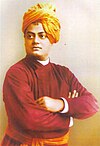Ramakrishna Mission Swami Vivekananda's Ancestral House and Cultural Centre
| Ramakrishna Mission Swami Vivekananda's Ancestral House and Cultural Centre | |
|---|---|
Swamiji Bhavan | |
 Entrance to the Ramakrishna Mission Swami Vivekananda's Ancestral House and Cultural Centre | |
| Former names | Swami Vivekananda's ancestral house |
| General information | |
| Status | Active |
| Type | Heritage place, museum |
| Address | 105 Vivekananda Road |
| Town or city | Kolkata |
| Country | India |
| Coordinates | 22°35′10.8″N 88°22′2.5″E / 22.586333°N 88.367361°E |
| Construction started | 26 September 2004 |
| Inaugurated | 26 September 2004 |
| Renovated | 2004 |
| Owner | Ramakrishna Mission |
Ramakrishna Mission Swami Vivekananda's Ancestral House and Cultural Centre is a museum and cultural centre. It is located at 105 Vivekananda Road, Kolkata, India.[1] In this house, Swami Vivekananda (then called Narendranath Datta) was born on 12 January 1863.[2] The house remained Vivekananda's home throughout his childhood and early youth.[3][4] The cultural centre was inaugurated by the President of India A. P. J. Abdul Kalam.[5]
History
[edit]After the death of his father (Vishwanath Datta) in 1884, Narendranath's aunt, who was living with them in that house, claimed full possession of the property. She filed a lawsuit against Narendranath's mother (Bhuvaneswari Devi) and her family.[3] Vivekananda won the case in the lower court, but the case was appealed to a higher court.[6] The case continued for many years in higher courts. It concluded only a few days before Vivekananda's death in 1902. According to the final ruling in the case, Vivekananda was awarded full legal possession of his ancestral house.
Renovation
[edit]Over time, the ancestral house of Vivekananda became dilapidated. In 1962, Ramakrishna Mission authorities decided to acquire the property and turn it into a museum. In May 1999, the Ramakrishna Mission acquired the land and the adjacent plot through the Government of West Bengal. A committee was set up for this project. The committee managed to amass a fund of ₹200 million (US$2.4 million) from Central Government, State Government, and public donations of which ₹99 million (US$1.2 million) were granted by the Central Government.[5] In 2004, after renovation, the house was turned into a museum and cultural centre.[1]
Currently, Vivekananda's ancestral home is spread over 22,000 square feet[7] and houses a museum, a research centre, a memorial shrine, a library, an English centre, a computer training centre, and a charitable dispensary. Seminars and conventions are also regularly organised here.[4] There is a Shiva Lingam located at the premises.[7]
Gallery
[edit]-
Ancestral house of Vivekananda, now a museum and cultural centre
-
Bidhan Sarani, road in front of the house
-
Sign in front of the museum
-
Swami Vivekananda's birthplace
-
Statue of Swami Vivekananda adjacent to the house
References
[edit]- ^ a b "Ancestral House of Swami Vivekananda". Indfy. Retrieved 12 January 2013.
- ^ Chattopadhyay Rajagopal (1 January 1999). Swami Vivekananda in India: A Corrective Biography. Motilal Banarsidass. pp. 28–. ISBN 978-81-208-1586-5. Retrieved 13 January 2013.
- ^ a b Chaturvedi Badrinath (1 June 2006). Swami Vivekananda: The Living Vedanta. Penguin Books India. pp. 2–. ISBN 978-0-14-306209-7. Retrieved 12 January 2013.
- ^ a b "Ramakrishna Mission Swami Vivekananda's Ancestral House and Cultural Centre, Swamiji's House". BM Ramakrishna Mission Swami Vivekananda’s Ancestral House and Cultural Centre, Swamiji’s House. Retrieved 12 January 2013.
- ^ a b "Datta Ancestral Home - Birthplace of Vivekananda". Press Information Bureau (Government of India). Retrieved 12 January 2013.
- ^ Bhawan Singh Rana; Mīnā Agravāla Meena Agrawal (2005). The Immortal Philosopher Of India Swami Vivekananda. Diamond Pocket Books (P) Ltd. pp. 41–. ISBN 978-81-288-1001-5. Retrieved 12 January 2013.
- ^ a b "Swami Vivekananda's Ancestral House and Cultural Centre". Times of India Travel. Retrieved 10 May 2020.







